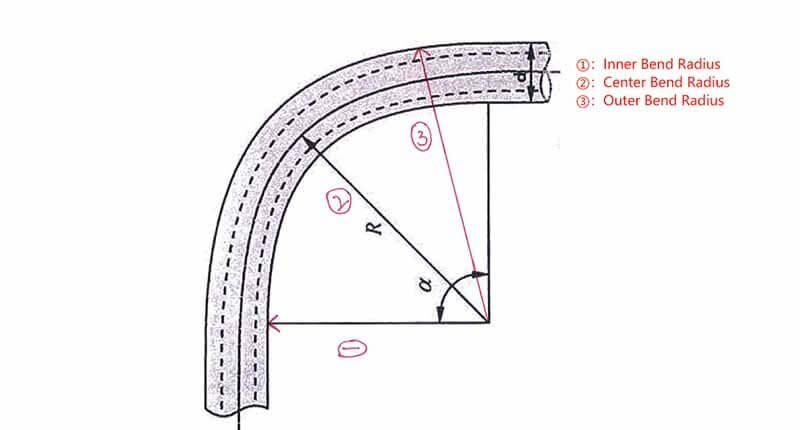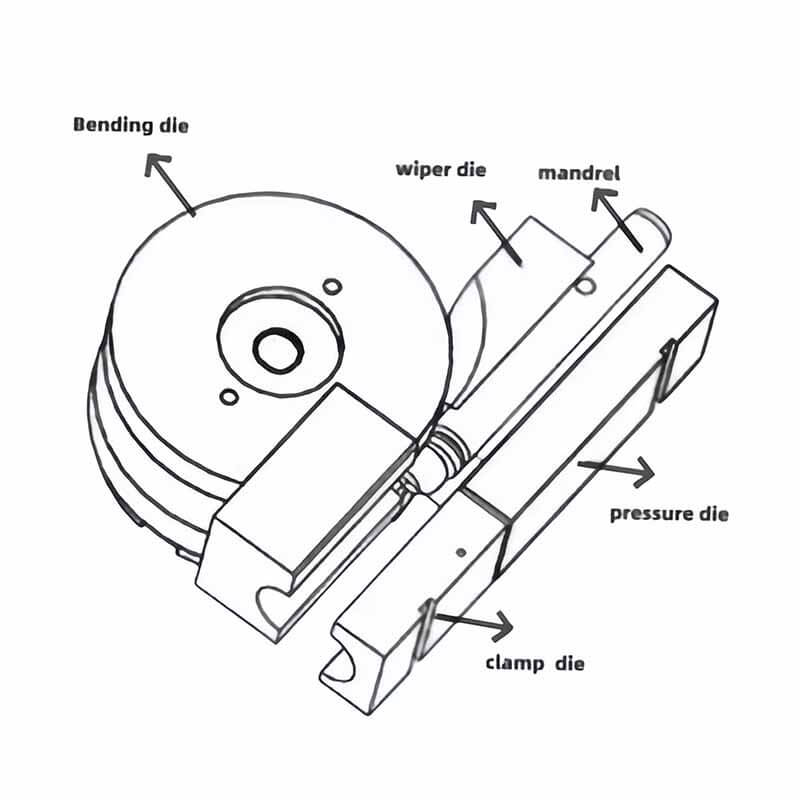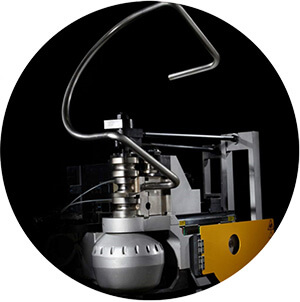All About Mandrel Tube Bender Q&A
- How to Calculate the Arc Length of the Bent Pipe?
- What is Pipe Bending Radius?
- How to Calculate the Pipe Bend Radius?
- What are the Components of a Complete Set of Mandrel Bending Machine Dies?
- Why Does Wrinkling Occur on the Inner Wall of the Pipe after Mandrel Bending and How to Fix it?
- What Causes Surface Dents on the Bent Tube and How to Address Them?
- What Causes Cracks to Appear on the Outer Side of the Bent Tail End?
- Why does Pipe Breakage Occur During Bending, and What are the Solutions?
- Why Does the End Section of the Bend Bulge, and How to Solve It?
- Why does Axial Double-Sided Bulging Occur in the Curved Section, and Its Solution?
- Why Does the Curved Section of the Mandrel Ball Exhibit Spherical Convexities, and What are the Solutions?
How to Calculate the Arc Length of the Bent Pipe?
Now, if you have a bent pipe in hand, but you don’t have drawing or CAD software to draw its measurement, here is the pipe bending formula to calculate the length of the arc:
You should know the pipe bending angle and bending radius first. For example, if your bending angle is 90°, then the bent pipe arc length should be:
L= 3.14×R÷180×90
This is the arc length result. If you want to know the entire pipe length before bending, measure the length of straight sections at both ends, plus them, and you will get the answer.
Here, the L means the bent pipe arc length, and R means the bending radius.
What is Pipe Bending Radius?
Pipe bending radius means the distance from the center of the pipe to the center of the arc formed by the bending process. Here, you have to pay attention: when you need to calculate the bending radius for your supplier to purchase the pipe bending die, purchase the pipe bending machine, or bend the pipe in your own factory, the bending radius is typically assumed to be the center bend radius.
Here show you what is the Outer Bend Radius, Center Bend Radius, and Inner Bend Radius.

How to Calculate the Pipe Bend Radius?
The same, if you have a bend radius calculator or put the drawing into CAD software to measure the size. If you do not have one, here is another tube bending formulas for you to calculate another important parameter in tube bending – that is pipe bend radius.
R= πd(θ/360)/θ
R means tube bend radius, π is 3.14, d means tube diameter, and θ means bend angle.
- The calculation of the bending radius is only applicable to pipes with bending angles less than 180 degrees.
What are the Components of a Complete Set of Mandrel Bending Machine Dies?
A complete set of mandrel bending machine dies includes: a bending die, clamp die, pressure die, mandrel, and wiper die.

Why Does Wrinkling Occur on the Inner Wall of the Pipe after Mandrel Bending and How to Fix it?
Indeed, while mandrel bending minimizes wrinkling compared to other bending techniques, it’s not entirely foolproof. Let’s explore other reasons for wrinkling during bending and how to address them.
Reason: The tip of the wiper die is thick and positioned forward, creating a step behind the bending die cutting point. During bending, the inner metal of the pipe is compressed, and with low material hardness, it accumulates here, causing wrinkling on the inner wall of the pipe.
Solution: Repair the thickness of the wiper die tip, reduce the thickness of the wiper die tip; polish the wiper die tip to smooth transition with the bending die surface; in the case of no wrinkles, retract the wiper die until the accumulation disappears.
What Causes Surface Dents on the Bent Tube and How to Address Them?
In some cases, after bending the tube, you may notice some dents on its surface. Do you know what causes this?
Reason: The mandrel size is small, or when adjusting the mold, the pushing speed exceeds the rotation speed too much, and the pressure and pushing force are too high.
Solution: Choose the correct mandrel size, reduce the pushing speed, as well as the pressure and pushing force.
What Causes Cracks to Appear on the Outer Side of the Bent Tail End?
Reason: The mandrel surface is rough or there are metal shavings between the ball and the mandrel rod; the inner surface of the pressure die cavity is irregular, with undulations or metal shavings; the pressure die against the pipe too tightly, causing excessive frictional resistance and resulting in fractures.
Solution: Check for defects on the surface of the mandrel or pressure die cavity, and repair the mold promptly if any are found; reduce the assist and die pressure, increase the clearance between the pressure die and wiper die; remove metal shavings and debris from the mold surface.
Why does Pipe Breakage Occur During Bending, and What are the Solutions?
Reason: The pipe surface exhibits noticeable transverse dents due to excessive pressure from the pressure die against the pipe, resulting in excessive frictional resistance and subsequent breakage; the mandrel dimensions are too large, leading to tight fitment of the pipe; the mandrel position exceeds the intersection point of the bending dies by too much; excessive die pressure and insufficient assist and clamping pressures cause slipping and breakage; oil on the pressure die, clamp die, or pipe surface causes surface slippage and breakage; smooth mold surfaces cause pipe slippage and breakage; assist speed is lower than rotational speed, resulting in thinning and breakage of the pipe wall; improper lubrication or rough surface of the mandrel causes excessive resistance and breakage; ball size on the mandrel exceeds the maximum mandrel size, causing excessive resistance and breakage; excessive gap between the center of the maximum ball size and the end size of the mandrel results in deformation during pipe clamping, leading to pipe breakage.
Solution: Strictly control the surface quality of the pipe material; adjust the assist speed or rotational speed; check if the mandrel dimensions or position are appropriate; inspect the clamp die and pressure die surfaces for oil and clean them; check if the clearance between the pressure die and wiper die, and the bending die is appropriate and adjust as necessary; check if the pressure of clamp die and pressure die are appropriate and adjust accordingly; if the clamp still cannot hold after adjusting the pressure and clearance, consider adding an auxiliary mandrel or roughening the clamp die cavity surface; lubricate the mandrel or polish it with emery cloth, and check if the mandrel material and lubricant are compatible with the pipe material; if the distance between the ball and the end of the mandrel is too long, adjust the clearance between the ball and the mandrel.
Why Does the End Section of the Bend Bulge, and How to Solve It?
Reason: The mandrel exceeds the intersection point of the wheel dies by too much during adjustment.
Solution: Retract the mandrel until the bulge disappears; if wrinkles appear, increase the number of mandrel balls.
Why does Axial Double-Sided Bulging Occur in the Curved Section, and Its Solution?
Reason: The mold cavity size is too small or the pipe diameter size is large, causing the metal to be squeezed into an ear-shaped bulge under high pressure.
Solution: Use bending molds with correct cavity sizes; reduce die pressure/assist pressure, increase clearance between pressure die and wiper die/wheel dies, or reduce assist stroke; lubricate mold cavity edges appropriately, and strictly control pipe dimensions.
Why Does the Curved Section of the Mandrel Ball Exhibit Spherical Convexities, and What are the Solutions?
Reason: The pressure die is pressed too tightly, and the assist force is less than the bending tension; the mandrel ball joint pitch is too large.
Solution: Reduce the die pressure, increase the assist force; reduce the mandrel ball joint pitch.
You may also interested in:

Denis Lau
Denis Lau has 20 years of work experience in the metal processing industry. His major in university was mechanical engineering, and after graduation, he started from the bottom of the workshop, gaining extensive hands-on professional experience and the ability to tackle challenges from various industries.


